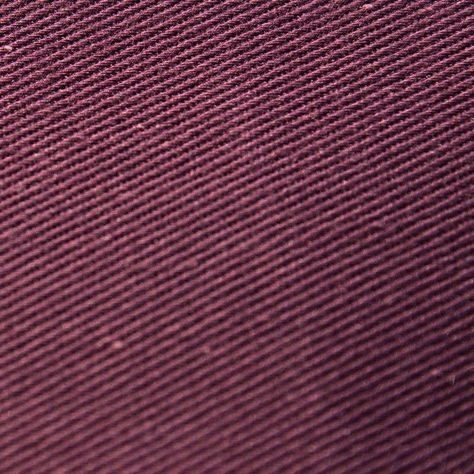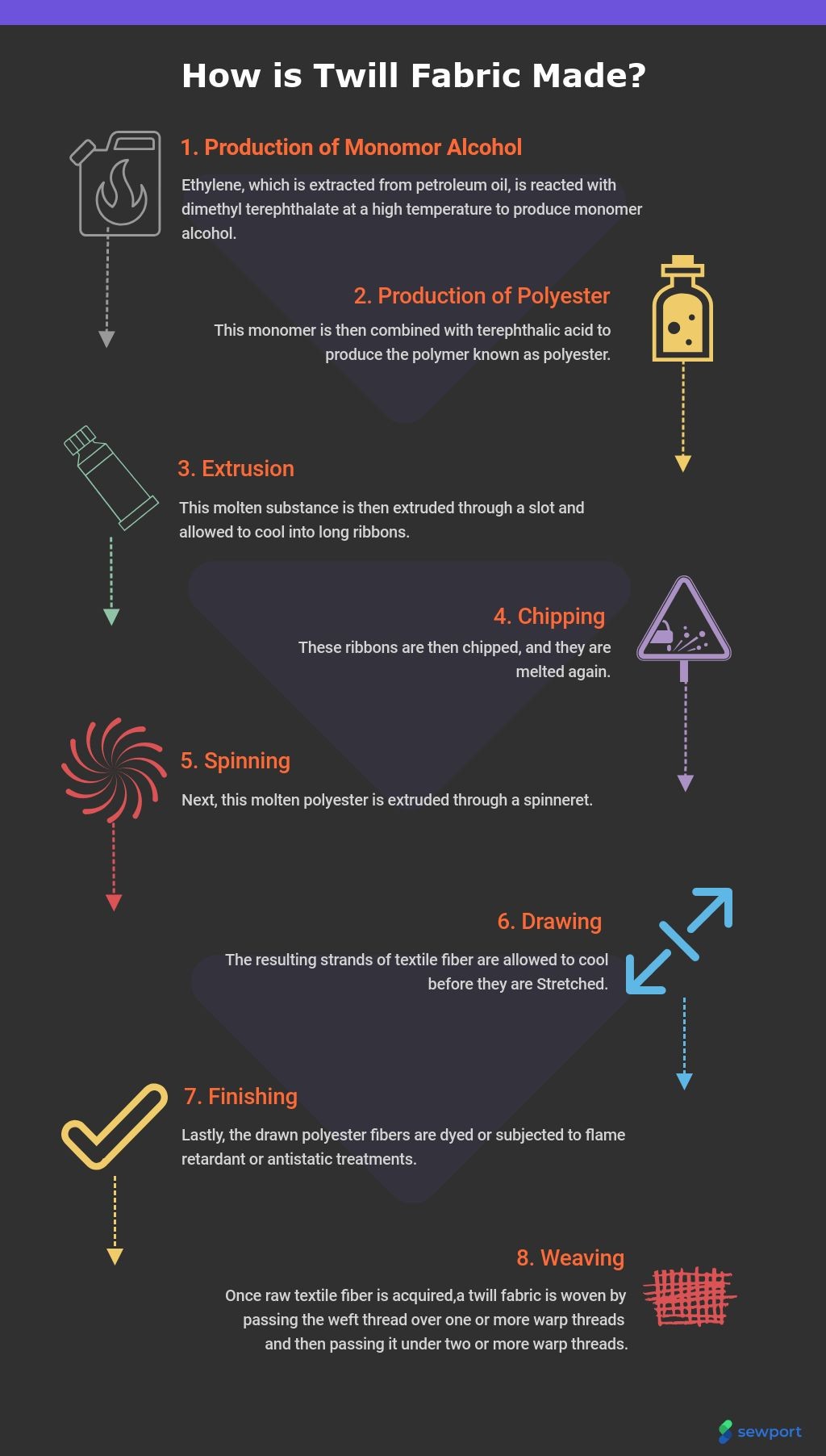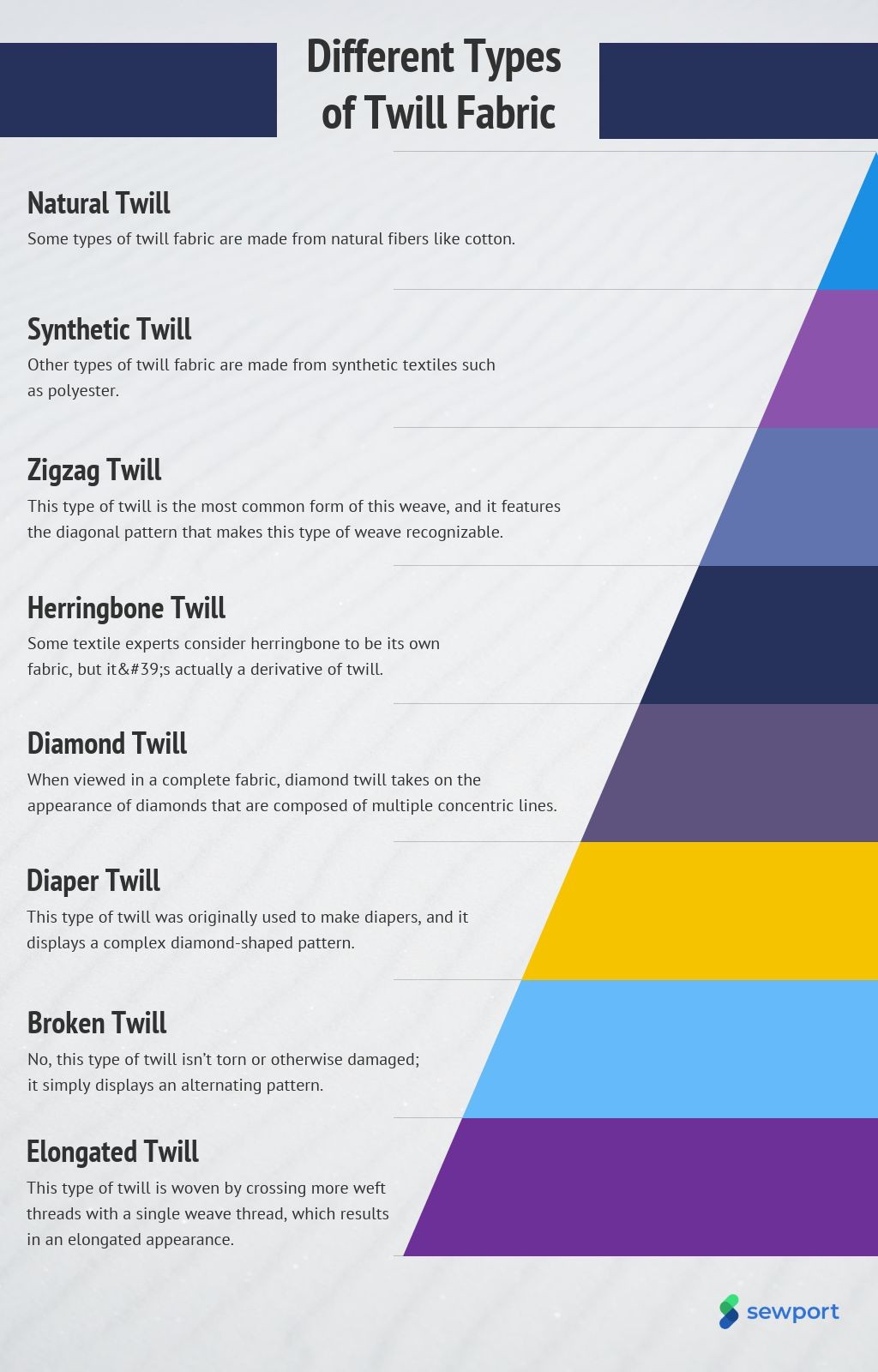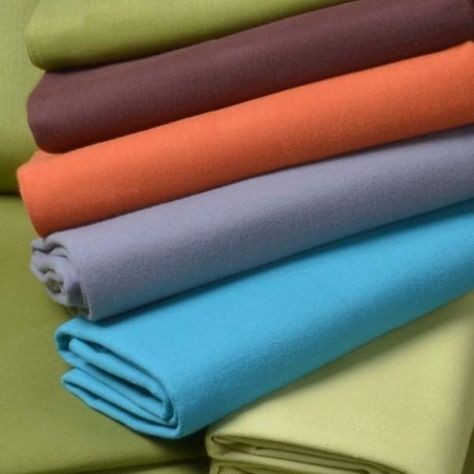Twill is a distinctive fabric weave known for its diagonal rib pattern, offering a unique texture and drape. Curious about twill and its many applications? WHAT.EDU.VN is here to unravel all your questions about this versatile textile. From its construction to its environmental impact, we’ll explore every aspect of twill, providing you with a clear and comprehensive understanding. Dive in to discover the world of twill weave, diagonal weave, and fabric structure.
1. What is Twill Fabric?
Twill fabric is characterized by its diagonal ribs or lines on the face of the fabric. This distinctive weave is created by passing the weft thread over one or more warp threads, then under two or more warp threads, creating a “step” pattern. Unlike plain weave, which has a simple over-and-under structure, twill’s diagonal pattern gives it a unique texture and drape.
1.1. Twill Weave Explained
The twill weave is one of the three fundamental types of textile weaves, along with plain weave and satin weave. The key difference lies in the pattern of interlacing threads.
| Weave Type | Interlacing Pattern | Characteristics |
|---|---|---|
| Plain | Over one, under one | Simple, durable, inexpensive |
| Twill | Over one or more, under two or more | Diagonal ribs, durable, drapes well |
| Satin | Over four or more, under one | Smooth, lustrous, prone to snagging |




1.2. History of Twill
Twill has been around for thousands of years, with evidence of its use found in ancient textiles from various cultures. The term “twill” itself comes from the Old English word “twili,” derived from the Latin “bilix,” highlighting its long-standing presence in textile production.
1.3. Common Twill Fabrics
Many fabrics use twill weave, including:
- Denim: A sturdy cotton twill used for jeans and jackets.
- Chino: A lightweight cotton twill often used for pants.
- Gabardine: A tightly woven twill known for its durability and water resistance.
- Drill: A strong, medium-weight twill often used for workwear.
2. How is Twill Fabric Made?
The process of making twill fabric involves several steps, starting with the selection of fibers and ending with the weaving process.
2.1. Fiber Selection
Twill can be made from various fibers, including natural fibers like cotton and wool, as well as synthetic fibers like polyester and rayon. The choice of fiber affects the fabric’s properties, such as its durability, drape, and breathability.
2.2. Yarn Production
Once the fibers are selected, they are spun into yarn. This process involves twisting the fibers together to create a continuous strand. The yarn can be dyed at this stage, or the fabric can be dyed after weaving.
2.3. Weaving Process
The weaving process is where the twill fabric gets its distinctive diagonal pattern. The warp threads are held taut on a loom, and the weft thread is passed over and under the warp threads in a specific pattern.
2.4. Finishing
After weaving, the fabric undergoes finishing processes to improve its appearance and performance. These processes may include washing, dyeing, printing, and applying finishes to enhance its properties, such as water resistance or wrinkle resistance.
3. What are the Different Types of Twill Fabric?
Twill fabric comes in various types, each with unique characteristics and applications.
3.1. Warp-Faced Twill
In warp-faced twill, the warp threads dominate the face of the fabric. This type of twill is typically more durable and resistant to abrasion. Denim is a common example of warp-faced twill.
3.2. Weft-Faced Twill
In weft-faced twill, the weft threads dominate the face of the fabric. This type of twill tends to have a softer feel and better drape.
3.3. Balanced Twill
Balanced twill has an equal amount of warp and weft threads on the face of the fabric. This type of twill offers a good balance of durability and drape.
3.4. Twill Variations
Several variations of twill weave create different patterns and textures:
- Herringbone Twill: Features a distinctive V-shaped pattern resembling the bones of a herring.
- Diamond Twill: Creates a diamond-shaped pattern through alternating twill directions.
- Broken Twill: An irregular twill weave with an uneven surface.
- Elongated Twill: Characterized by longer floats, creating a smoother surface.
4. What are the Uses of Twill Fabric?
Twill fabric is used in a wide range of applications due to its durability, drape, and versatility.
4.1. Apparel
Twill is a popular choice for clothing items such as:
- Jeans
- Pants (chinos, dress pants)
- Skirts
- Jackets
- Shirts
4.2. Home Textiles
Twill is also used in home textiles, including:
- Bedding (sheets, duvet covers)
- Curtains
- Upholstery
- Tablecloths
- Towels
4.3. Industrial Applications
Due to its durability, twill is used in industrial applications such as:
- Workwear
- Uniforms
- Bags and luggage
- Awnings and tents
5. What are the Benefits of Twill Fabric?
Twill fabric offers several benefits that make it a popular choice for various applications.
5.1. Durability
Twill is known for its durability, making it ideal for items that need to withstand wear and tear.
5.2. Drape
The diagonal weave of twill gives it a good drape, allowing it to hang nicely on the body or on furniture.
5.3. Wrinkle Resistance
Twill is less prone to wrinkling compared to plain weave fabrics, making it a good choice for travel or everyday wear.
5.4. Texture
The diagonal ribs of twill create a subtle texture that adds visual interest to the fabric.
6. How to Care for Twill Fabric?
The care requirements for twill fabric depend on the type of fiber it is made from.
6.1. Washing
Most twill fabrics can be machine washed in cold or warm water. Always check the care label for specific instructions.
6.2. Drying
Tumble dry on low heat or hang to dry. Avoid high heat, which can cause shrinkage or damage the fibers.
6.3. Ironing
Iron on medium heat if needed. Use a pressing cloth to protect the fabric from shine.
6.4. Storage
Store twill garments in a cool, dry place. Avoid storing them in direct sunlight, which can cause fading.
7. Twill Fabric and the Environment
The environmental impact of twill fabric depends on the fibers used and the manufacturing processes employed.
7.1. Natural Fibers
Twill made from natural fibers like cotton can be more sustainable if grown and processed using environmentally friendly methods.
7.2. Synthetic Fibers
Twill made from synthetic fibers like polyester has a higher environmental impact due to the use of fossil fuels and the potential for microplastic pollution.
7.3. Sustainable Practices
Look for twill fabrics made from organic cotton or recycled polyester to reduce your environmental impact.
8. Twill Fabric vs. Other Weaves
Understanding the differences between twill and other common weaves can help you make informed choices about fabric selection.
8.1. Twill vs. Plain Weave
| Feature | Twill Weave | Plain Weave |
|---|---|---|
| Pattern | Diagonal ribs | Simple over-and-under pattern |
| Durability | More durable | Durable |
| Drape | Better drape | Stiffer drape |
| Wrinkle Resistance | More wrinkle-resistant | More prone to wrinkles |
| Texture | Subtle texture | Smooth texture |
8.2. Twill vs. Satin Weave
| Feature | Twill Weave | Satin Weave |
|---|---|---|
| Pattern | Diagonal ribs | Smooth, lustrous surface |
| Durability | Durable | Less durable |
| Drape | Good drape | Excellent drape |
| Wrinkle Resistance | More wrinkle-resistant | Prone to wrinkles |
| Texture | Subtle texture | Smooth texture |
9. Frequently Asked Questions (FAQs) about Twill Fabric
Here are some common questions about twill fabric:
| Question | Answer |
|---|---|
| What is the difference between twill and denim? | Denim is a specific type of twill fabric made from cotton, typically with a warp-faced construction. Twill is a broader category of weave that includes denim but also encompasses other fabrics like chino and gabardine. |
| Is twill fabric breathable? | The breathability of twill fabric depends on the fiber content. Cotton twill is more breathable than polyester twill. |
| Is twill fabric stretchy? | Twill fabric generally has low stretch, but some twill fabrics may incorporate elastic fibers like spandex for added stretch. |
| Is twill fabric waterproof? | Twill fabric is not inherently waterproof, but it can be treated with water-resistant finishes to provide some protection from moisture. |
| How can I identify twill fabric? | Look for the distinctive diagonal ribs on the face of the fabric. You can also check the fabric’s weave structure by examining it closely or using a magnifying glass. |
| What Is Twill tape used for? | Twill tape is a narrow strip of twill fabric used for reinforcing seams, binding edges, and creating casings. It is commonly used in sewing and garment construction. |
| Can twill fabric be dyed? | Yes, twill fabric can be dyed. The dyeing process depends on the fiber content of the fabric. |
| Is twill fabric suitable for summer? | Cotton twill can be suitable for summer, as it is breathable and lightweight. However, heavier twill fabrics may be too warm for hot weather. |
| What are the best uses for cotton twill? | Cotton twill is best used for apparel like pants, skirts, and jackets, as well as home textiles like bedding and curtains. |
| How does twill compare to canvas? | Twill and canvas are both durable fabrics, but twill has a diagonal weave while canvas has a plain weave. Twill generally has a better drape than canvas. |
10. Conclusion: The Enduring Appeal of Twill Fabric
Twill fabric is a versatile and durable textile with a distinctive diagonal weave. Its wide range of applications, from apparel to home textiles, and its many benefits, including durability, drape, and wrinkle resistance, make it a popular choice for designers and consumers alike.
Do you have more questions about twill or any other topic? Visit WHAT.EDU.VN today and ask your question for free. Our community of experts is ready to provide you with the answers you need. Don’t hesitate – your questions are welcome here.
Address: 888 Question City Plaza, Seattle, WA 98101, United States
WhatsApp: +1 (206) 555-7890
Website: what.edu.vn